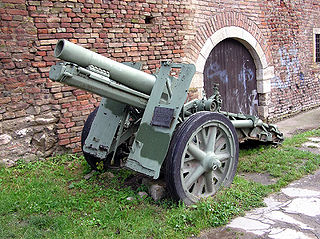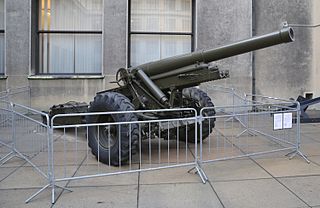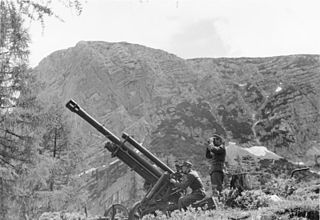
The 15 cm sIG 33 was the standard German heavy infantry gun used in the Second World War. It was the largest weapon ever classified as an infantry gun by any nation.

The Škoda 149 mm K series was a line of heavy howitzer designs that served with Germany, Turkey, Romania, Slovakia, and Yugoslavia during World War II.

The 152 mm howitzer-gun M1937 (ML-20), is a Soviet heavy gun-howitzer. The gun was developed by the design bureau of the plant no 172, headed by F. F. Petrov, as a deep upgrade of the 152-mm gun M1910/34, in turn based on the 152-mm siege gun M1910, a pre-World War I design by Schneider. It was in production from 1937 to 1946. The ML-20 saw action in World War II, mainly as a corps / army level artillery piece of the Soviet Army. Captured guns were employed by Wehrmacht and the Finnish Army. Post World War II, the ML-20 saw combat in numerous conflicts during the mid to late twentieth century.
A gun carriage is a frame or a mount that supports the gun barrel of an artillery piece, allowing it to be maneuvered and fired. These platforms often had wheels so that the artillery pieces could be moved more easily. Gun carriages are also used on ships to facilitate the movement and aiming of large cannons and Guns. These are also used in the funeral procession of any higher authority of any state and country.

The Ordnance BL 6 inch 26cwt howitzer was a British howitzer used during World War I and World War II. The qualifier "26cwt" refers to the weight of the barrel and breech together which weighed 26 long hundredweight (1.3 t).

The D-1 howitzer M1943 is a Soviet World War II-era 152.4 mm howitzer. The gun was developed by the design bureau headed by F. F. Petrov in 1942 and 1943, based on the carriage of the 122 mm howitzer M1938 (M-30) and using the barrel of the 152 mm howitzer M1938 (M-10). The powerful and mobile D-1, with its wide range of ammunition, significantly increased the firepower and breakthrough abilities of Red Army tank and motor rifle formations. Several hundred D-1s were manufactured before the end of World War II.

152-mm howitzer M1938 (M-10) was a Soviet 152.4 mm howitzer of World War II era. It was developed in 1937–1938 at the Motovilikha Mechanical Plant by a team headed by F. F. Petrov. Although production of the gun was stopped in 1941, it saw combat with the Red Army until the end of World War II and remained in service until the 1950s. Captured pieces were used by Wehrmacht and the Finnish Army. The latter kept the M-10 in service until 2000.

The 15 cm schwere Feldhaubitze 18 or sFH 18, nicknamed Immergrün ("Evergreen"), was the basic German division-level heavy howitzer of 149mm during the Second World War, serving alongside the smaller but more numerous 10.5 cm leFH 18. Its mobility and firing range and the effectiveness of its 44 kilogram shell made it the most important weapon of all German infantry divisions. A total of 6,756 examples were produced.

152 mm howitzer M1910/37 was a limited production Soviet 152.4 mm howitzer, a modernization of the 152 mm howitzer M1910, initially designed by Schneider. The gun was employed by Red Army in World War II.

The 10.5 cm leFH 18 is a German light howitzer used in World War II and the standard artillery piece of the Wehrmacht, adopted for service in 1935 and used by all divisions and artillery battalions. From 1935 to the end of the war, 11,848 were produced, along with 10,265 of the leFH 18/40 variant.

152 H 88 is the name of a series of modernized 152 mm towed heavy howitzers with 32 caliber barrels. The guns of the series share the same barrel as well as other similar qualities, but differ slightly in appearance, since they consist of three different, older (modernized) versions. The modernization was carried out by Vammas Oy from 1988 to mid-1990s. The modernization project consisted of numerous modifications to the guns, some of which had already undergone earlier smaller modifications. The most important change was the replacement of the original barrels by a Finnish-made 152 mm barrel. Also the gun carriages were subjected to various modifications. After the modernization, increased towing speeds were made possible. The breech mechanism is manually operated in all the guns. All the 152 H 88 series artillery pieces are being withdrawn from service and scrapped.

The Canon de 155 C modèle 1917 Schneider, often abbreviated as the C17S, was a French howitzer designed by Schneider. It was essentially the Canon de 155 C modèle 1915 Schneider fitted with a different breech to use bagged propellant rather than the cartridge cases used by the older howitzer. It was used by France, Russian Empire, Belgium, Romania, and the United States from 1917 during World War I and was widely exported after the war. Surviving weapons were in service with France, Poland, Greece, Italy, Belgium, the United States, and Finland during World War II. Captured weapons were used by the Germans for their 2nd-line artillery and coast defense units.

The 10.5 cm leFH 18/40 was a German light howitzer used in World War II.

The 15 cm schwere Feldhaubitze 13, was a heavy field howitzer used by Germany in World War I and the beginning of World War II.

The 10 cm schwere Kanone 18 was a field gun used by Germany in World War II. The German army wanted a new 10.5 cm gun as well as 15 cm howitzer which were to share the same carriage. Guns are heavier than howitzers due to the longer barrel. This also led to the 15 cm sFH 18. As such both weapons had a similar weight and could be carried by a similar carriage. By 1926 Krupp and Rheinmetall had specimen designs, and prototypes were ready by 1930, but was not fielded until 1933–34. Both Krupp and Rheinmetall competed for the development contract, but the Wehrmacht compromised and selected Krupp's carriage to be mated with Rheinmetall's gun.

The 10.5 cm Feldhaubitze 98/09, a short barreled (1625 mm) 105mm howitzer, also referred to as the 10.5 cm leichte Feldhaubitze 98/09, was used by the German Empire, Kingdom of Romania as well as the Ottoman Empire in World War I and after. It had a maximum range of 6,300 metres (20,700 ft).

The 15 cm schwere Feldhaubitze 1902 was a German heavy field howitzer cannon introduced in 1903 and served in World War I.

The 15 cm schwere Feldhaubitze M 94 was a heavy howitzer used by Austria-Hungary in World War I. It had a bronze barrel and relied on wheel ramps to absorb its recoil. The barrel was modified in 1899 as the M 99 and can be identified by its octagonal shape. Both howitzers could be mounted on a wide variety of carriages to suit their mission, including a carriage only 1.13 metres (44 in) wide for mountain use. Around the start of the 20th century both the M 94 and M 99 were modified to increase their elevation up to 65°. The elevation arc had to be extended and the trunnion mounts and wheels had to be strengthened to withstand the greater recoil forces when firing at high elevation. They were known as the M 94/4 and the M 99/4 after modification.

The 10.5 cm Gebirgshaubitze 40 was a 10.5 cm (4.1 in) German mountain howitzer used during World War II. A total of 420 were built during World War II. It saw action with German mountain divisions in Finland, Italy, France, on the Eastern Front and in the Balkans from 1942. It served with a number of European countries into the 1960s.

The 15 cm sFH 93 was a German howitzer which served in a number of colonial conflicts, the Balkan Wars and World War I.



















